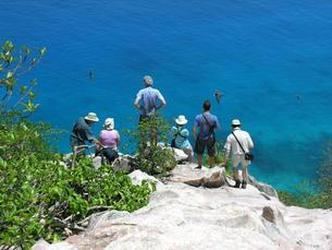Major islands Aride Width 0.6 km (0.37 mi) Area 71 ha | Total islands 1 Length 1.65 km (1.025 mi) Elevation 135 m | |
 | ||
Group La Digue and Inner Islands Similar Curieuse Island, Cousin Island, Sainte Anne Marine N, Vallée de Mai, Anse Lazio | ||
Aride island in the seychelles
Aride Island is the northernmost granitic island in the Seychelles (Bird Island is the northernmost Seychelles island overall). A nature reserve, it is leased and managed by the Island Conservation Society of Seychelles.
Contents
- Aride island in the seychelles
- Map of Aride Seychelles
- History
- Geography
- Demographics
- Government services
- Tourism
- Transport
- Cuisine
- Flora and fauna
- References
Map of Aride, Seychelles
History
The name ‘Aride’ first appears on nautical charts after French voyages of exploration in 1770 and 1771. The first written account was in 1787 by Jean-Baptiste Malavois, French commandant of Seychelles, who described it as being “…no more than a pile of rocks covered with a few bushes.” Between 1817 and 1829 Aride was possibly an unofficial leper colony. In 1868, the Irishman Perceval Wright, who gave his name to Aride’s unique gardenia and one of its endemic lizards, visited Aride. In 1883, the British artist Marianne North painted a scene on the island, reporting just one large tree, beneath which the island staff sheltered from the sun. Coconut palms were planted over much of Aride and copra production became important economically. Dogs, pigs, cats and chickens were introduced, though fortunately rats never arrived.
The wooden plantation house on Aride, overlooking the small settlement, is one of the last buildings of its type to survive in Seychelles.
For almost a century sooty tern eggs were cropped with up to 220,000 being removed each season. Not surprisingly the number of nesting seabirds declined and all endemic land birds were wiped out. However, in 1967, the island’s owner, Paul Chenard, ceased egg collection and declared the island a reserve. In 1973, Mr. Christopher Cadbury purchased Aride for the Society for the Promotion of Nature Reserves (now Royal Society of Wildlife Trusts). In 1979 it was declared a Special Reserve under Seychelles law, to include a marine zone of 200m around the island, with penalties including imprisonment for killing or disturbance of its wildlife.
In 2003, management was transferred to Island Conservation Society. In 2006, the freehold was transferred to the UK Registered Charity Island Conservation Society UK and in 2008, the island was leased back to Island Conservation Society of Seychelles.
Geography
The island is part of the district of Grand'Anse, located 10 km north of Praslin island and is 68 hectares in area.
Demographics
The only human inhabitants are the reserve's staff; currently four Seychellois rangers, two expatriate Conservation Officers and two volunteers. They live in the main village of the island, La Cour, on the south side of the island.
Government services
Being an island with a small population, there are not any government buildings or services. For many services, people have to go to Praslin.
Tourism
Today, the island's main industry is tourism, and it is known for its beaches, especially Turtle beach. The island is also visited for its wide variety of underwater creatures like fish, sharks and rays. One can go on a boat trip or a diving trip around the island.
Transport
the main means of transportation is bicycles.
Cuisine
Fish is the main ingredient.
Flora and fauna
Over 1.25 million seabirds regularly breed on Aride including the world's largest colony of lesser noddy, the largest Seychelles population of roseate tern and the world's largest colony of tropical shearwater. There is also an enormous roost of non-breeding frigatebirds.
There are five species endemic to Seychelles resident on Aride. The Seychelles warbler was introduced from Cousin Island to Aride in 1988 and its population is now the largest in the world with over 2,000 pairs. The Seychelles fody was also introduced from Cousin in 2002, as well the Seychelles magpie robin from Fregate Island. The Seychelles blue pigeon and the Seychelles sunbird have re-colonised Aride naturally.
Reptilian fauna includes several species of skink, three species of gecko and three species of non-poisonous snakes. Green turtles and hawksbill turtles are regular visitors to the beaches of Aride.
Aride is the only place in the world where the flowering shrub Wright's gardenia Rothmannia annae is endemic.
